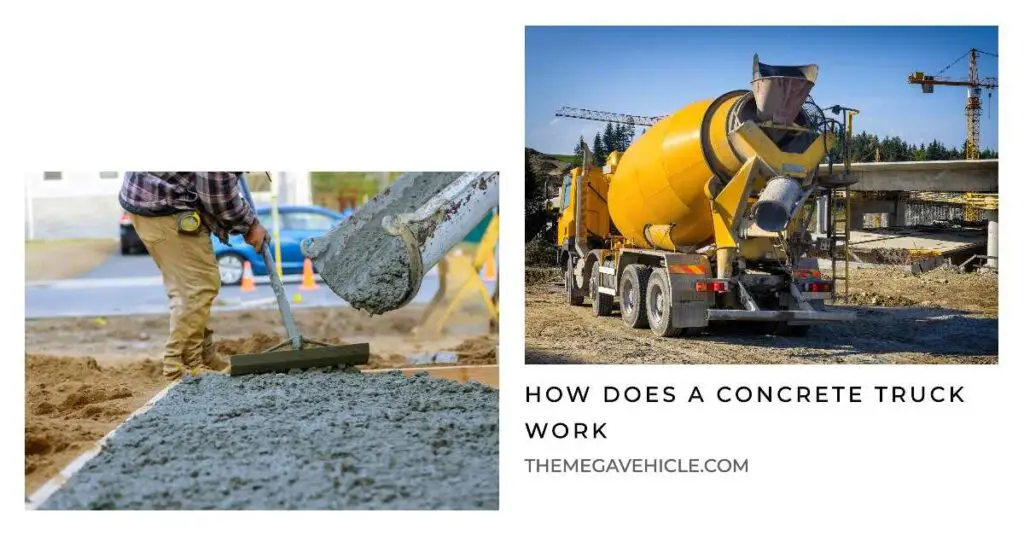A concrete or cement mixer truck is a specialized vehicle for mixing and transporting concrete. It typically has a large rotating drum mounted on the back, which allows the concrete ingredients to be thoroughly mixed during transportation. These trucks are commonly seen at construction sites and are essential for delivering ready-mixed concrete to various locations.
Concrete trucks play a crucial role in construction projects by ensuring the timely and efficient delivery of concrete to the desired locations. They eliminate the need for manual mixing of concrete on-site, saving time and labor costs. Additionally, these trucks allow for precise control over the consistency and quality of the concrete, ensuring that it meets the specific requirements of each project.
Let’s look at the components of a concrete truck before we go into detail about how does a concrete truck work.
Table of Contents
Components of a Concrete Truck
A concrete truck consists of several components that work together to ensure the efficient delivery and mixing of concrete. Here are some of the essential components:
- Concrete Drum
- Water Tank and pump
- Hopper
- Chutes
- Control Panel
Each component plays a vital role in ensuring the efficient transportation and delivery of high-quality concrete. From maintaining proper mixing consistency in the drum to controlling discharge rates through chutes, these components work together to facilitate the successful completion of construction projects.
How Does A Concrete Truck Work
A concrete truck combines cement, water, and aggregates (such as sand, gravel, or crushed stone) to produce concrete on-site. Here’s a simplified overview of how does a concrete truck work:
1. The Concrete Drum: Mixing and Transporting the Perfect Blend
The concrete drum is a crucial component of a cement mixer truck. It is designed to hold and mix concrete ingredients, including cement, aggregates, and water. The mixing blades inside the drum ensure the materials are thoroughly blended, creating a homogenous mixture. The rotational motion of the drum allows for continuous mixing while in transit, ensuring that the concrete remains well-mixed and ready for use upon arrival at the construction site.
2. The Water Tank and Pump: Adding Precision to the Mixing Process
The water tank allows for precise measurement and control of the water-to-cement ratio, ensuring the desired consistency of the concrete mixture. The water pump system provides a steady flow of water into the drum, while the water flow control allows for adjustments during the mixing process, ensuring optimal hydration of the cement and aggregates.
3. The Hopper: Loading and Discharging Materials Efficiently
The hopper is responsible for storing and dispensing the aggregates, ensuring a steady supply to the mixer. It is designed to prevent any clogging or segregation of materials, ensuring a consistent mix. It has a cement silo discharge system that allows for controlled and precise cement discharge into the mixer, preventing any wastage or spillage. These components contribute to an efficient and reliable mixing process, resulting in a high-quality end product.
4. Chutes: Channeling and Pouring Freshly Mixed Concrete at Construction Sites
Chutes are designed to deliver the concrete from the mixer to the desired location easily and precisely. The chutes are made of durable materials that can withstand the weight and pressure of the concrete, ensuring a smooth and efficient flow. Additionally, they can be adjusted or extended to reach different heights or distances, allowing for flexibility in construction projects. Overall, chutes play a crucial role in the concrete pouring process, improving productivity and accuracy on construction sites.
The Operational Process of a Concrete Truck
The operation process of a concrete truck in action involves several steps. First, the truck is positioned at the designated pouring location, and the concrete is loaded into the truck’s drum.
During loading, the truck’s drum is carefully filled with the correct proportions of cement, aggregates, and water to create a well-balanced mixture. Similarly, the drum rotates in reverse during the discharging process to efficiently release the concrete through the chute, allowing for controlled and accurate placement.
This controlled placement is crucial for ensuring the concrete is poured in the desired location without spills or waste. Additionally, the drum rotation during discharge helps to distribute the concrete evenly, preventing any inconsistencies in its composition and strength.
Frequently Asked Questions
Q1. How many yards does a concrete truck hold?
A. A typical concrete truck can hold between 8 to 10 cubic yards of concrete. This capacity allows for efficient transportation and delivery of large quantities of concrete to construction sites, minimizing the need for multiple trips and maximizing productivity.
Q2. How much does a 10-yard concrete truck weigh?
A. A 10-yard concrete truck typically weighs around 30,000 pounds when empty. However, when fully loaded with concrete, it can weigh up to 70,000 pounds.
Q3. How much does a concrete mixer truck cost?
A. On average, a new concrete mixer truck can range from $70,000 to $200,000. However, it’s important to note that concrete mixer truck prices can vary depending on several factors, such as brand, size, capacity, and additional features.

